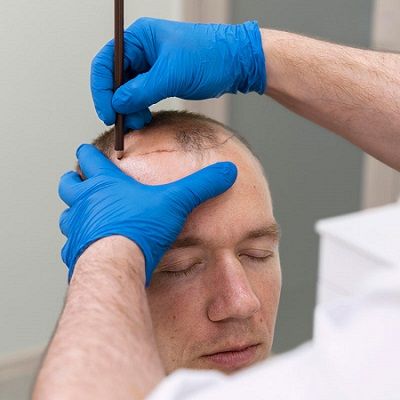
Hair is a crucial component of skin ornamentation. Hair completes the personality of the individual. But many people do not have enough hair that can groom their personalities. A large frequency of people is facing hair loss irrespective of gender and age. Old people face hair loss due to increasing age and genetics. However, young ones are facing it due to malnutrition and insufficient intake of water. They do not eat enough meat and vegetables that can fulfill their need for protein. Lack of protein causes the hair to weaken and it ultimately causes hair loss. If we look at conservative management they do stop hair loss but do not reverse its growth. Cosmetic treatments help to restore hair through certain management. Over and above that, people want to know about FUE Hair Transplant vs. Other Hair Restoration Techniques to choose the perfect procedure for them.
What is it?
Follicular Unit Extraction is a minimally invasive procedure. In this procedure, the doctor extracts follicles individually and implants them on the bald area. The area from where he takes the follicles refer as the donor area. On the flip side, the area where he inserts the follicular unit is the recipient area.
The follicles extract from the back and side of the scalp because these areas are less prone to hair loss and have a definite amount of hair. It requires local anesthesia as it is slightly intrusive and may cause pain.
Comparison with other techniques
Other than FUE there are several other techniques that can help to restore hair. Some are invasive methods while some are completely non-invasive. However, the choice of treatment totally depends on the results they bring forth.
FUT vs FUE:
It is a surgical procedure. In this method, the surgeon removes the strip of the scalp from the back or side of the scalp. He then extracts the hair follicles from the donor area and transplants them into the recipient area. The hair then gradually grows on that part after 3 to 4 months.
On the other hand, FUE transplants the healthier hair from the donor area which is usually the back or side of the scalp. And transplants them into the recipient area. The hair in the receiver area grows the same way as the donor area over time.
DHI vs FUE:
DHI hair transplant is another method of transferring hair. It uses a special instrument which is the Choi Implanter pen. This specialized tool aids in ensuring that the transplanted follicles are put into the scalp in an organized and accurate manner. Unlike FUE, it does not require any holes or incisions before implanting hair follicles.
FUSS vs FUE:
FUSS is follicular unit strip surgery. As per the name, in this procedure, the doctor takes a strip of hair follicles from the back and side of the scalp and harvests them into the area of baldness. It helps to treat both male and female baldness patterns.
While on comparison with FUE, FUSS harvests a strip of hair follicles while FUT only transplants individual follicles one by one. Moreover, it also needs stitches to close the donor area after transplantation. On the same hand, FUE does not require any stitches.
Procedure:
This procedure requires complete preparation. Before initiating the treatment, the doctor confirms that you are appropriate for this procedure. Moreover, he discusses your desired results and explains the procedure to you.
- The doctor first examines your scalp and gets an idea about the amount of hair loss.
- He cleanses and disinfects the scalp before the initiation.
- Marks the recipient area for identification.
- Provide local anesthesia to the patient to ease the pain and discomfort throughout the procedure.
- He first prepares the recipient area by making a small incision using a specific tool so that there is a place for the insertion of follicles.
- Extracts the hair follicle from the donor area and insert them into the preprepared receiver area.
- The hair follicles must be placed in the direction of the original hair.
Aftercare:
After the procedure, the doctor advises aftercare measures to follow. This preventive measure helps you recover earlier. Furthermore, it helps to achieve the desired results and enables the treatment to fulfill your expectations.
- Apply ointments on the scar to increase its healing
- Eat medicines like antibiotics according to the prescription of a doctor. To guarantee the complete healing of the wound.
- Keep your scalp clean
- Do not carry out exhausting exercises that may cause sweating. Because sweating can increase the risk of infection
- Do not move out in the sun as it can cause exposure to UV radiation
- Consume a well-balanced diet that contains protein-rich foods
- Apply sunblock on your scalp
- Cover your scalp to reduce its availability for dirt and bacteria
- Quit smoking and alcoholic beverages
Benefits:
The results of this procedure totally depend on the patient’s condition. The recovery period lasts between 1 to 2 weeks after the treatment. However, visible hair growth is seen after a few months. The original sheds after the procedure but this is not a bad sign. The doctors consider it a good sign as it allows the new healthy hair to grow. FUE also provides effective and long-lasting results
- A slightly encroaching procedure.
- A hospital stay after the procedure is not important. You can return home once the procedure completes.
- Requires no bed rest.
- Provides natural-looking results.
- Does not leaves scars after the treatment.
- Makes you look younger and more appealing.
Book A Consultation
People who want to choose between FUE Hair Transplant vs. Other Hair Restoration Techniques should consult our doctors. Our Dynamic Aesthetic Clinic in Dubai has well-qualified and experienced doctors that encounter thousands of similar patients and suggest them treatment according to their conditions. If you want to get this treatment from our clinic under the supervision of the experts. Simply fill out the consultation form. Our team will contact you in no time and book your appointment.











